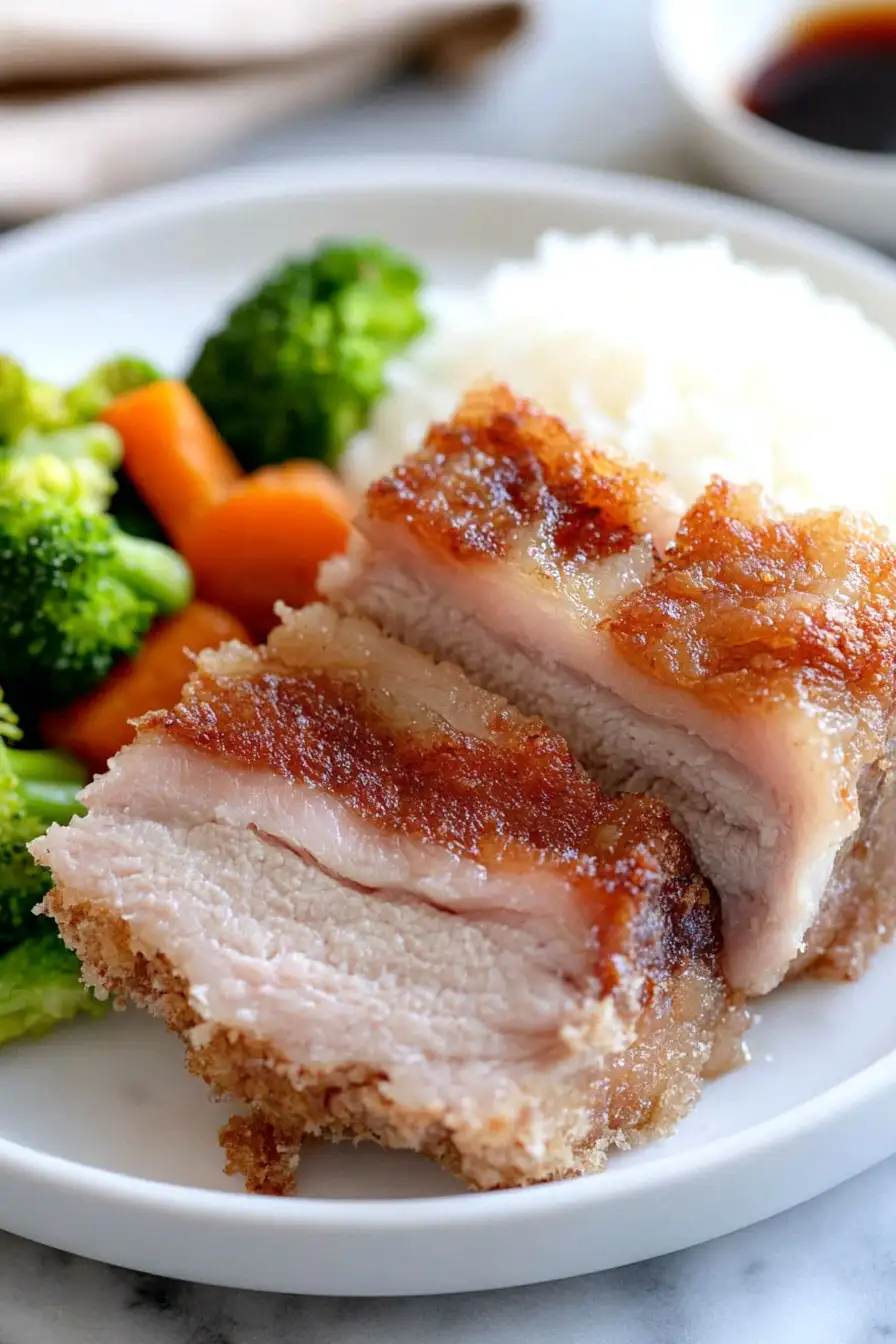Getting that perfect crackling on pork belly can feel like an impossible kitchen mission. Between managing the cooking temperature, timing each stage just right, and hoping the skin turns out crispy (not chewy), it’s no wonder many home cooks shy away from attempting this classic dish at home.
But here’s the good news – this foolproof crackling pork belly recipe breaks it all down into simple steps that anyone can follow, giving you that crunchy top layer and tender meat underneath every single time. Plus, it’s a dish that’s perfect for weekend family dinners or when you want to impress guests without spending the whole day in the kitchen.

Why You’ll Love This Pork Belly
- Crispy, crunchy skin – The cooking method creates that satisfying crackling on top that pork lovers dream about – it’s like having the best part of bacon, but better.
- Melt-in-your-mouth meat – The long, slow cooking process makes the meat underneath incredibly tender and juicy, creating an amazing contrast with the crispy top.
- Simple ingredients – You only need three ingredients to make this impressive dish – it’s proof that sometimes less is more in the kitchen.
- Make-ahead friendly – While it takes time to cook, most of it is hands-off oven time, making it perfect for weekend cooking or special occasions when you’re home anyway.
What Kind of Pork Belly Should I Use?
For the crispiest crackling, look for pork belly that has an even thickness throughout and a good ratio of meat to fat layers. The most important part is making sure you get a piece with the skin on – this is absolutely essential for achieving that crunchy crackling top. Fresh pork belly from your butcher is ideal, but many grocery stores now carry good quality options in their meat section. When selecting your piece, check that the skin is free from holes, scores or blemishes, as these can affect how evenly the crackling develops. If you’re buying from a butcher, ask them to remove any stray hairs from the skin but not to score it – you’ll want to do this part yourself at home to ensure even cuts.

Options for Substitutions
When it comes to this pork belly recipe, some ingredients are essential while others can be switched up:
- Pork belly: This is the star of the show and can’t really be substituted – you need pork belly with the skin on to achieve that signature crackling. Make sure to ask your butcher for a piece with even thickness.
- Coarse salt: If you don’t have coarse salt, you can use kosher salt instead. Table salt isn’t recommended as it’s too fine and might make the meat too salty. If using kosher salt, use the same amount.
- Chinese-style seasoning mix: Don’t have Chinese seasoning mix? You can make your own by combining equal parts of five-spice powder, white pepper, and garlic powder. Or try a simple mix of black pepper, garlic powder, and ginger powder. Just avoid wet seasonings as they can prevent the skin from crisping up.
Watch Out for These Mistakes While Roasting
The secret to perfect crackling lies in keeping the pork skin completely dry – any moisture will prevent that coveted crispy texture, so pat the skin thoroughly with paper towels and let it air dry in the fridge uncovered for at least 4 hours or overnight. A common mistake is not scoring the skin properly – make sure your cuts are evenly spaced and just deep enough to reach the fat layer without cutting into the meat. Another crucial error is starting with a cold oven – always preheat thoroughly, as the initial blast of high heat (around 450°F) is essential for creating those beautiful bubbles in the crackling. To avoid chewy or rubbery skin, don’t rush the final crisping stage – if some parts aren’t crackling after the cooking time, switch to the broiler for a few minutes while watching carefully to prevent burning.

What to Serve With Pork Belly?
This rich and indulgent pork belly pairs perfectly with sides that can balance out its fatty, savory goodness. A simple bowl of steamed white rice or fluffy noodles makes an excellent base to soak up all those tasty juices. For some freshness and crunch, try serving it with Asian-style pickled vegetables or a crisp cucumber salad dressed with rice vinegar. I also love adding some stir-fried baby bok choy or Chinese broccoli on the side – the green vegetables help cut through the richness of the pork and round out the meal nicely.
Storage Instructions
Keep Fresh: Your leftover crackling pork belly will stay good in the fridge for up to 3 days when stored in an airtight container. The crackling might lose some of its crispiness, but the meat will remain juicy and flavorful. I recommend keeping the meat and crackling portions separate if possible to prevent the crispy skin from getting soft.
Freeze: While you can freeze cooked pork belly for up to 2 months in a freezer-safe container, keep in mind that the crackling won’t stay crispy once thawed. The meat itself freezes well though, so if you’re planning to make a big batch, consider freezing just the meat portion.
Revive: To get that crackling crispy again, pop it under the broiler for 2-3 minutes while watching carefully. For the meat, warm it in the oven at 350°F for about 15-20 minutes, covered with foil to keep it from drying out. If frozen, thaw overnight in the fridge before reheating.
| Preparation Time | 360-420 minutes |
| Cooking Time | 90-100 minutes |
| Total Time | 450-520 minutes |
| Level of Difficulty | Medium |
Estimated Nutrition
Estimated nutrition for the whole recipe (without optional ingredients):
- Calories: 1800-2100
- Protein: 120-140 g
- Fat: 150-170 g
- Carbohydrates: 0-5 g
Ingredients
For the pork belly:
- 2 lb pork belly with skin (preferably a slab about 1.5-2 inches thick for even cooking)
For the seasoning:
- 1/4 cup coarse salt
- 2-3 tbsp Chinese five-spice powder (or any other Chinese-style seasoning mix)
Step 1: Prepare the Pork Belly
Start by rinsing the pork belly under cold water.
Scrape the top of the skin thoroughly to remove any remaining particles or hair.
Once cleaned, pat the skin completely dry using a paper towel.
This is important for achieving crispy skin later on.
Step 2: Piercing and Seasoning
Using a sharp metal skewer, poke numerous holes into the skin of the pork belly.
Be cautious to only pierce through the skin and avoid going into the meat itself.
Aim for making at least 200 small holes.
Next, generously season the meat side of the pork belly with Peking seasoning.
Take care to avoid getting any spices on the skin.
Step 3: Dry the Pork Belly
Place the seasoned pork belly in the refrigerator with the skin side up, keeping it uncovered to facilitate drying.
Allow it to dry for as long as possible, preferably overnight or for a minimum of 6 hours.
This step is crucial for achieving a crispy skin.
Step 4: Prepare for Cooking
Preheat your oven to 350°F (175°C).
Create a foil boat around the pork belly by folding up the sides and sealing the corners tightly, leaving the skin exposed on top.
This helps contain the rendered fat and direct heat onto the skin.
Carefully cover the exposed skin with a thick layer of coarse salt, ensuring the salt stays on top and doesn’t spill over the sides.
Step 5: Cook the Pork Belly
Place the foil-wrapped pork belly on the center rack of the oven.
Position a drip pan underneath to collect any oils or fat that may drip off during cooking.
Bake for approximately 1.5 hours, or until the pork reaches an internal temperature of 160-165°F (71-74°C).
Step 6: Finishing Touches
Once cooked, remove the pork belly from the oven.
Let it rest a bit before handling to avoid burns.
Carefully break away the salt crust from the top skin and discard it.
Your pork belly is now ready to be sliced and enjoyed!
Serve as desired and relish the savory flavors and crispy texture.
Bon appétit!

